|
|
 |
|
|
Talvinsota will never end!
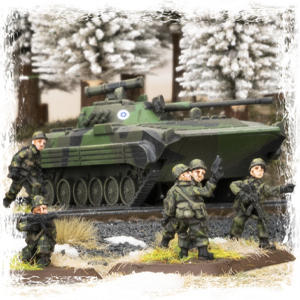 |
Talvinsota will never end!
By Livio Tonazzo
The legend of the Finnish infantry begins in 1939 during the so-called Winter War, or Talvinsota in Finnish. The small Finnish army offered a strenuous resistance against the Red Army, superior in men and tanks with hallucinating proportions. The Finns knew how to take advantage of their knowledge of the area, using ambush and guerrilla tactics that put the invaders in serious difficulty. Even during the Second World War (or Continuation War), the Finns gave excellent proof of themselves, fighting on the northern front until 1945. The peace treaty that followed almost completely restored the borders to those of 1 January 1941.
|
|
The situation of Finland during the Cold War was not easy due to its proximity to the Soviet Union. Throughout the 1960s and 1970s, the Finns modernized their forces, replacing much of their World War II vintage equipment and weapons with new systems from both the West and Warsaw Pact. Despite the purchases of some Main Battle Tanks (T-54, T-55, T-72) Finnish doctrine remained strongly defensive, with infantry thus playing a key role. However, it is not a question of foot infantry, but rather of mechanized infantry as equipped with BMP and BTR.
|
|
In the new book Nordic Force, the Suomen Maavoimat (the Finnish Army) can deploy two infantry formations that differ substantially in vehicles available to the infantry platoons.
|
|
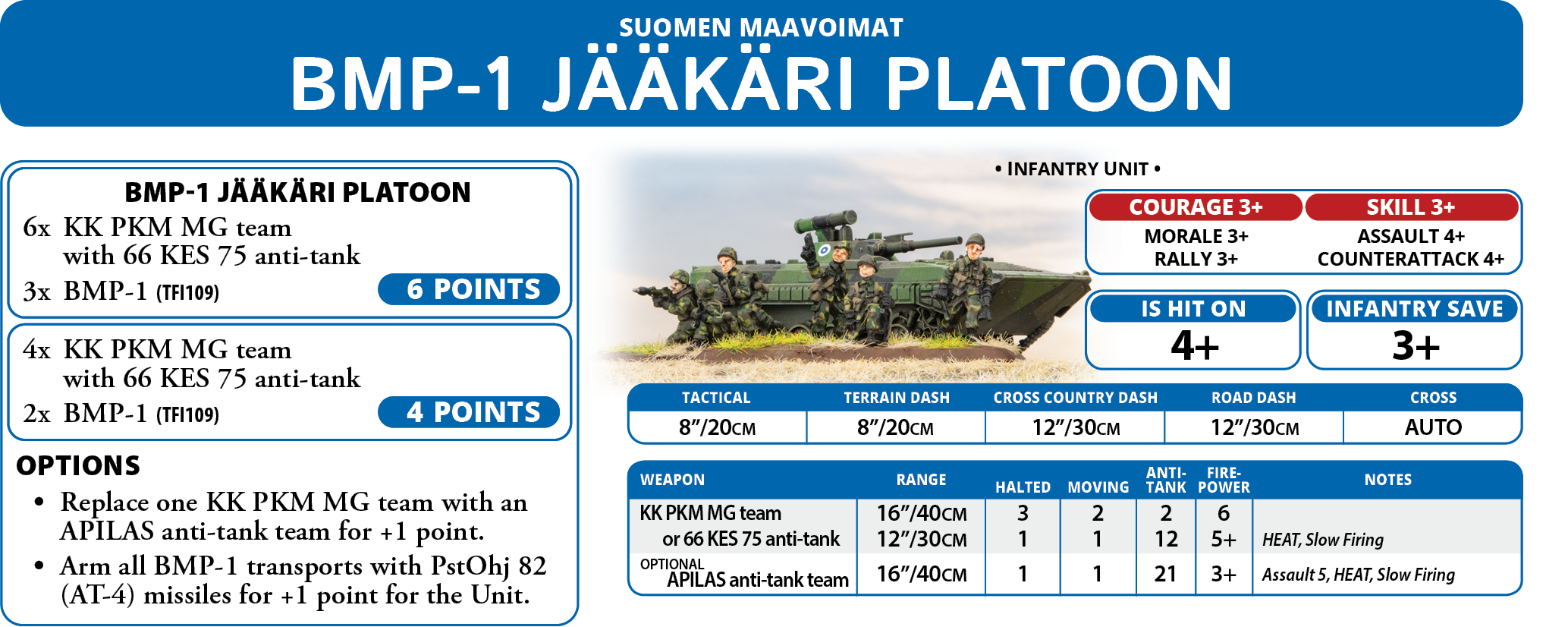
|
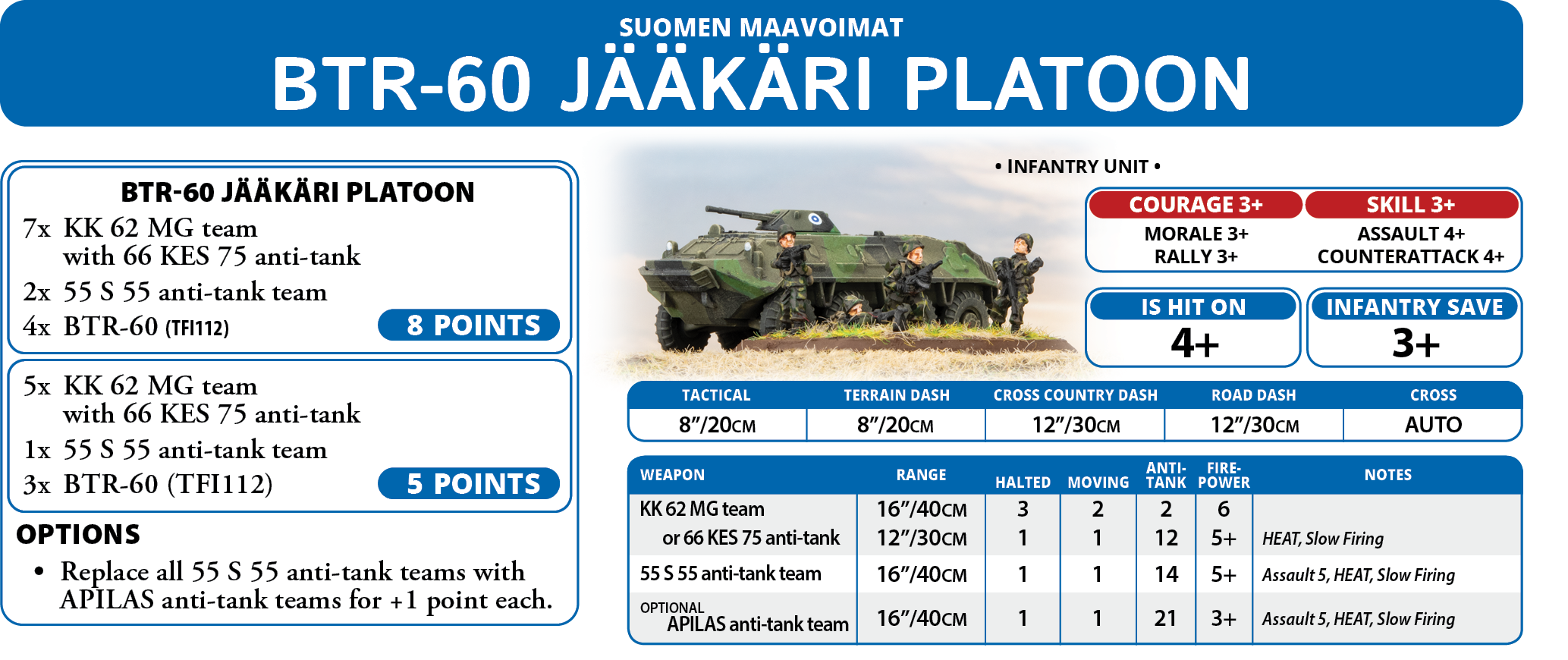 |
|
Both BMP-1 Jaakari Company and BTR-60 Jaakari Company can field up to three mechanized infantry units of which two are compulsory (black box). Beyond the vehicles, the composition of the platoons is also slightly different precisely because it is designed to be complementary to them.
|
|
BMP-mounted Jaakari platoons consist of full strength 6 bases of MG infantry (ROF 3 when HALTED, ROF 2 when MOVING) of which one may be replaced by an APILAS anti-tank team. The APILAS is particularly fearsome as it is capable of hitting enemies within 16” with an Anti-Tank of 21 and can also fight in assault. For the small extra cost it entails, it is worth deploying. Alternatively, the foot soldiers can be reduced to 4 teams, to slightly contain the cost.
|
|
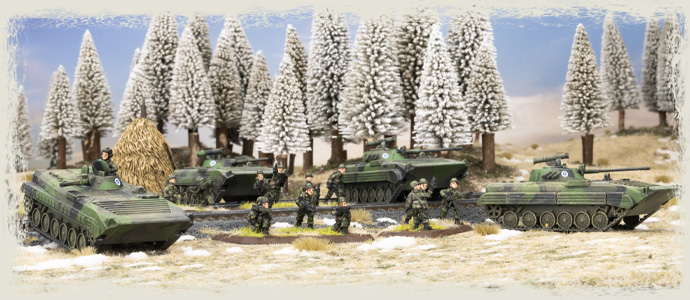
|
|
The number of BMP accompanying them on the battlefield also varies with the number of infantrymen. A full-strength platoon counts on two BMPs, while a reduced-strength one only has two. The formation bears the name of BMP-1 and this suggests the BMP model prevalent within it. However, one of the infantry platoons (one of the compulsory ones, therefore the unit can be chosen as Formation Support) can be equipped with the most modern BMP-2. These automatically bring an AT-5 missile to Anti-Tank 21 which is particularly fearsome, especially when combined with the ability to carry out Blitz orders with a Skill of 3+. I think this is the dream of all Warsaw Pact players! BMP-1s can also use AT-4 missiles, but to deploy these missiles to Anti-Tank 19 they are forced to pay a small extra cost as they are not included by default.
|
|
Overall a BMP-1 Jaakari Platoon is a fairly flexible unit, capable of developing a fair volume of anti-infantry fire and modest anti-tank fire at short ranges, however thanks to transports that can be equipped with missiles it can hit enemy tanks from a distance.
|
|
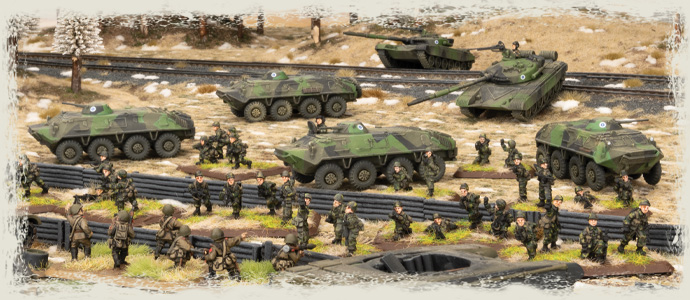
|
|
BTR-mounted Jaakari platoons consist of 7 bases of MG infantry and 2 bases of 55 S 55 anti-tank team at full strength or 5 bases of MG infantry and 1 base of 55 S 55 anti-tank team at half strength. It is therefore a slightly larger unit than the one embarked on the BMPs. Not being able to count on the anti-tank weapons of the IFV (Infantry Fighting Vehicle), the units embarked in BTRs have extra anti-tank teams at their disposal. The 55 S 55 anti-tank team can launch HEAT missiles with an anti-tank value of 14 and a Firepower of 5+. It is not a decisive weapon but it can be useful in assault. The APILAS anti-tank weapon we have already talked about is absolutely better, and decidedly more decisive both in assault and at a distance (although not too much). Since you can replace both 55S 55s it's a good idea to do so, the cost goes up but the unit becomes much more effective overall. Overall, Jaakari's BTR-mounted units are treacherous units. They cannot launch their missiles at long distances, but they can be very dangerous at short range and especially in assault thanks to the two APILAS. Also against infantry and light units, the BTR-60s can be very effective.
|
|
Both formations of Jaakari, whether equipped with BMP or BTR, can count on a unit of tanks in the ranks of the formation itself. This single slot can consist of all types of tanks supplied by the Finnish Army: T-55, T-72FM1 and T-72FM2. These are tanks with very different characteristics, roles and costs. The T-55 is a first-generation MBT which, by now, is roughly a light tank. The T-72FM1 is a second-generation MBT, which remains somewhat penalized by a medium/high cost and uncertain effectiveness. The T-72FM2 is not really a third-generation MBT, indeed it is far from it. However, it can count on the ERA armour which grants it a side armour of 16 against HEAT weapons. This value radically changes all the dynamics of assaults because many units, especially those of NATO, have little or no countermeasures. Since I would always take the Armor slot in any infantry formation, the choice of unit is more complex and the context must be evaluated. An almost 20-point unit like that of the T-72FM2 helps a lot in calculating reserves and can solve some complicated situations. On the other hand, it absorbs many points in a unit very vulnerable to all anti-tanks, especially from 21 and up.
|
|
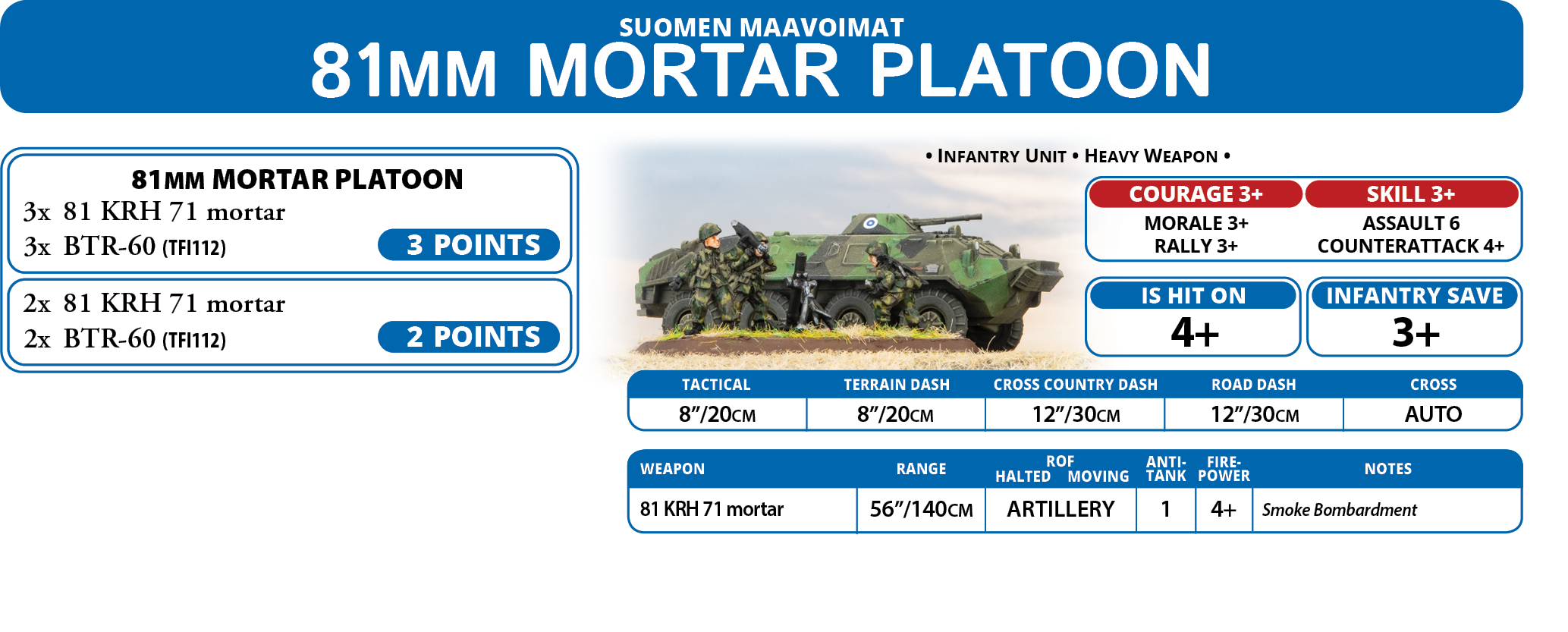
|
|
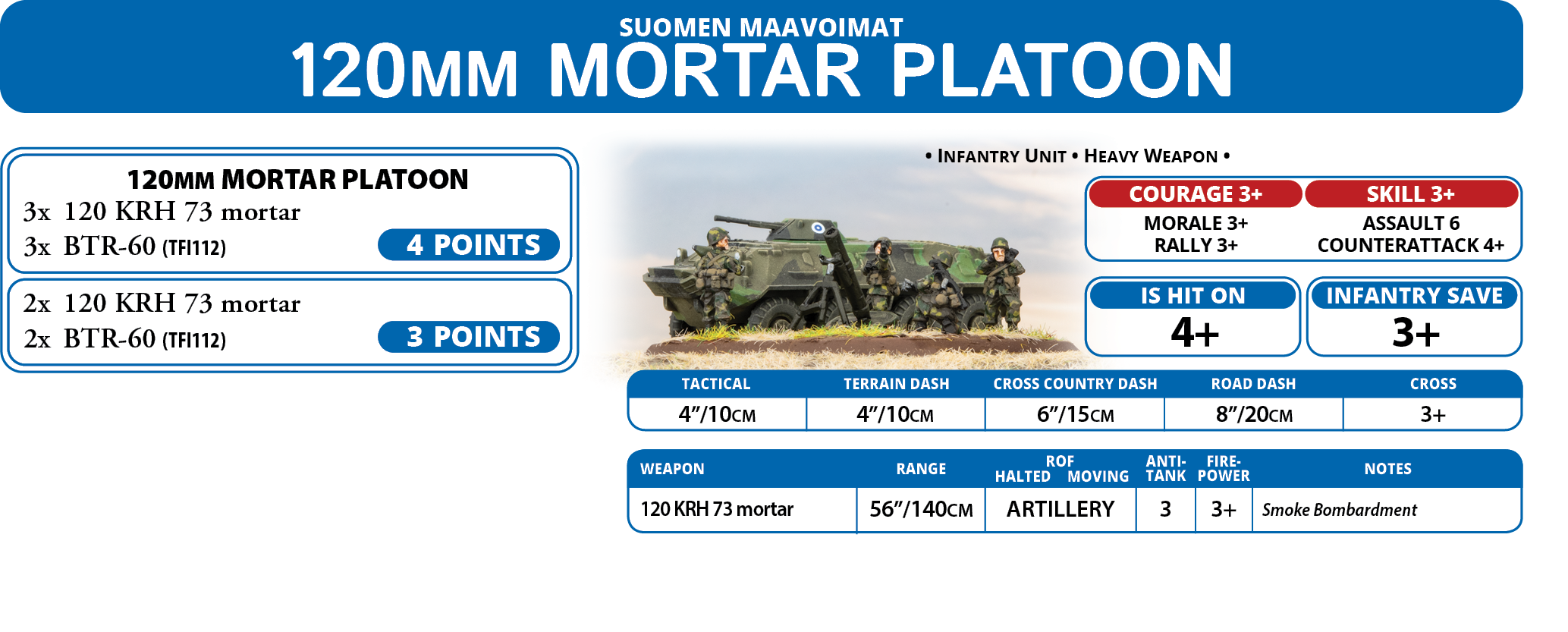
|
|
Each Formation of Jaakari can count on two Artillery slots. They consist of units of 82mm mortars and one unit of 120mm mortars. These are two really important if not fundamental units. In fact, for 7 points it is possible to deploy two units within the formation (which therefore prevent the break) capable of bombing and launching smoke bombs. This is a really useful addition that can give great results both offensively and defensively. Furthermore, always with that handful of points, you will be able to take two units of 3 BTR-60 which can actually be useful for destroying or at least harassing the opposing light units. What more do you want from life?
|
|
An anti-aircraft slot could not be missing in the lineup. It is the slimmest slot of all, being able to essentially count on only two bases armed with Grail. The cost is not exactly cheap, but it is a choice that could be evaluated to strengthen the formation a bit and add some extra anti-aircraft defences. Not being inside the platoons (as happens in the ranks of the Warsaw Pact) it is more difficult to pin these units as it is necessary to target them directly and invest a fire phase in them. The unit also includes a BTR-60 in case of rapid redeployment which however shouldn't be necessary given the range.
|
|
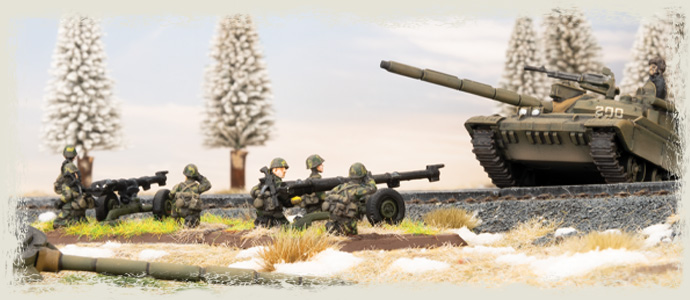
|
|
The most interesting unit in my opinion is instead found in the anti-tank slot. It is a unique unit of its kind and it deserves to be deployed for this reason alone. In reality, however, there are other excellent reasons. The unit I'm talking about is the 95 S 58-61 anti-tank platoon. It is a platoon armed with 3 anti-tank rifle recoilless. With a range of 24” they can engage units at (relative) range and destroy them thanks to their anti-tank value of 18 and a firepower of 2+. They can also count on HEAT ammunition to be fully effective even beyond 16". What makes them really interesting is the ROF of 2 which is particularly dangerous for light vehicles and the ability to shoot even at short range in defensive fire. But that's not all, it is also possible to add two APILAS anti-tank teams to the platoon, which increases their number (predicting unfortunate last stands, don't forget that they are infantry) and also guarantees defence against the heaviest tanks. Overall it is a unit that is nothing short of excellent, flexible and lethal in full Finnish style.
|
|
Now that we've reviewed the lineup it's time to set up the list.
|
|
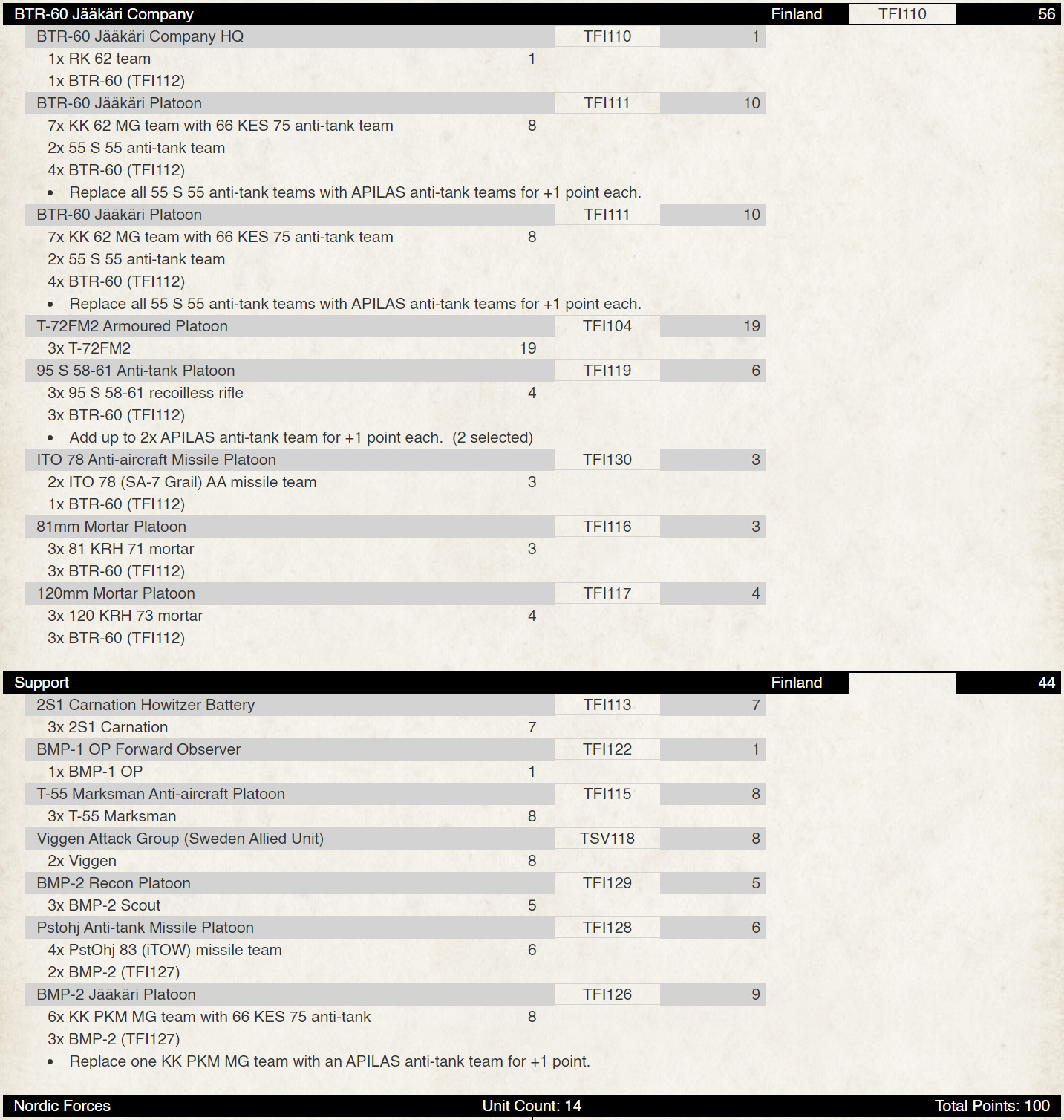
|
|
As you can see, this is a list heavily focused on infantry. I chose the BTR-60 formation because it was more numerous and because it was more solid overall given that the anti-tank 21 weapons are directly in the infantry and not in the vehicles. Having chosen a solid formation, with all slots apart from the third infantry, I am quite comfortable taking a platoon of BMP-2 Jaakari as Formation Support. This should give some extra missile range without affecting formation fragility or close-range combat capability. The TOWs of the support platoon and the scouts will increase the long-range shooting. For the medium-range one I naturally chose the excellent 95 S 58-61 anti-tank platoon. The anti-air defence is given by the T-55 Marksman and by the ITOs (which are there mostly to reinforce the formation). As for the armour choice, I decided on the T-72fm2 because they help manage reserves and because they can be the right unit to end the match with a decisive assault. As for the artillery, I naturally chose the two platoons of mortars which will be fundamental from an anti-infantry point of view, while I could not give up the Carnations which are very useful for destroying enemy light vehicles such as anti-aircraft, artillery or IFV with TOW. The Finns have some difficulty managing third-generation MBTs from a distance and for this, I have requested the support of two Swedish Viggen who with their maverick rockets could defeat those tanks that otherwise could only be destroyed in assault. You should never have too many hopes in aviation, but having it gives you a few more tactical options and makes your opponent break a sweat.
|
|
So good game and….TALVINSOTA!!!!!!!!
~ Livio
|
Last Updated On Thursday, August 17, 2023 by Ryan Smith
|
|
|